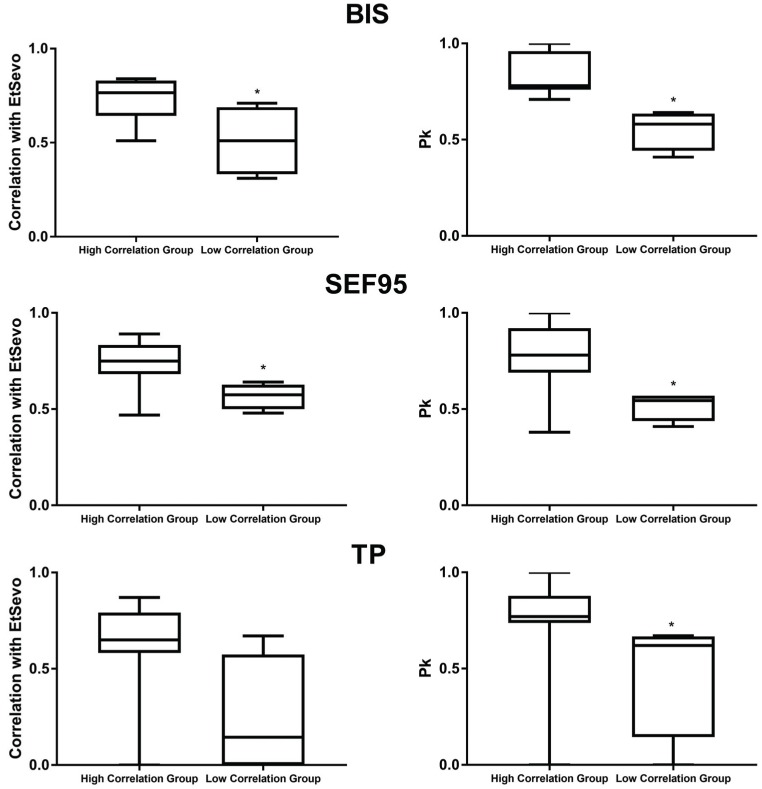J Dent Anesth Pain Med.
2018 Aug;18(4):235-244. 10.17245/jdapm.2018.18.4.235.
Analysis of electroencephalogram-derived indexes for anesthetic depth monitoring in pediatric patients with intellectual disability undergoing dental surgery
- Affiliations
-
- 1REQUIMTE, Faculdade de Farmácia da Universidade do Porto, Porto, Portugal. auramaia@gmail.com
- 2Anesthesiology, Centro Hospitalar do Porto-Hospital Geral de Santo António, Porto, Portugal.
- 3Politécnico do Porto, Escola Superior de Saúde, Porto, Portugal.
- 4Anesthesiology, Faculdade de Medicina da Universidade do Porto, Hospital de São João, Porto, Portugal.
- KMID: 2419065
- DOI: http://doi.org/10.17245/jdapm.2018.18.4.235
Abstract
- BACKGROUND
Patients with intellectual disability (ID) often require general anesthesia during oral procedures. Anesthetic depth monitoring in these patients can be difficult due to their already altered mental state prior to anesthesia. In this study, the utility of electroencephalographic indexes to reflect anesthetic depth was evaluated in pediatric patients with ID.
METHODS
Seventeen patients (mean age, 9.6 ± 2.9 years) scheduled for dental procedures were enrolled in this study. After anesthesia induction with propofol or sevoflurane, a bilateral sensor was placed on the patient's forehead and the bispectral index (BIS) was recorded. Anesthesia was maintained with sevoflurane, which was adjusted according to the clinical signs by an anesthesiologist blinded to the BIS value. The index performance was accessed by correlation (with the end-tidal sevoflurane [EtSevo] concentration) and prediction probability (with a clinical scale of anesthesia). The asymmetry of the electroencephalogram between the left and right sides was also analyzed.
RESULTS
The BIS had good correlation and prediction probabilities (above 0.5) in the majority of patients; however, BIS was not correlated with EtSevo or the clinical scale of anesthesia in patients with Lennox-Gastaut, West syndrome, cerebral palsy, and epilepsy. BIS showed better correlations than SEF95 and TP. No significant differences were observed between the left- and right-side indexes.
CONCLUSION
BIS may be able to reflect sevoflurane anesthetic depth in patients with some types of ID; however, more research is required to better define the neurological conditions and/or degrees of disability that may allow anesthesiologists to use the BIS.
MeSH Terms
Figure
Reference
-
1. Avidan MS, Jacobsohn E, Glick D, Burnside BA, Zhang L, Villafranca A, et al. Prevention of intraoperative awareness in a high-risk surgical population. N Engl J Med. 2011; 365:591–600. PMID: 21848460.
Article2. Punjasawadwong YS, Suraseranivongse S, Charuluxananan S, Jantorn P, Chanchayanon T, Tanudsintum S. Multicentered study of model of anesthesia related adverse events in Thailand by incident report (the Thai Anesthesia Incident Monitoring Study): methodology. J Med Assoc Thai. 2007; 90:2529–2537. PMID: 18181346.3. Ponnudurai RN, Clarke-Moore A, Ekulide I, Sant M, Choi K, Stone J, et al. A prospective study of bispectral index scoring in mentally retarded patients receiving general anesthesia. J Clin Anesth. 2010; 22:432–436. PMID: 20868964.
Article4. Choudhry DK, Brenn BR. Bispectral index monitoring: a comparison between normal children and children with quadriplegic cerebral palsy. Anesth Analg. 2002; 95:1582–1585. PMID: 12456420.
Article5. Valkenburg AJ, de Leeuw TG, Tibboel D, Weber F. Lower bispectral index values in children who are intellectually disabled. Anesth Analg. 2009; 109:1428–1433. PMID: 19843782.
Article6. Fudickar A, Jacobsen JH, Weiler N, Scholz J, Bein B. Bilateral measurement of bispectral index and mid-latency auditory evoked potentials in patients with unilateral brain lesions. J Crit Care. 2009; 24:545–550. PMID: 19577420.
Article7. Burnette CP, Henderson HA, Inge AP, Zahka NE, Schwartz CB, Mundy PC. Anterior EEG Asymmetry and the Modifier Model of Autism. J Autism Dev Disord. 2011; 41:1113–1124. PMID: 21107671.
Article8. Froom SR, Malan CA, Mecklenburgh JS, Price M, Chawathe MS, Hall JE, et al. Bispectral Index asymmetry and COMFORT score in paediatric intensive care patients. Br J Anaesth. 2008; 100:690–696. PMID: 18337270.
Article9. Fudickar A, Voss D, Serocki G, Jeckström W, Ambrosch P, Steinfath M, et al. Clinically relevant asymmetry of bispectral index during recovery from anaesthesia for ear-nose-throat surgery in adults and children. Anaesthesia. 2011; 66:936–941. PMID: 21851344.
Article10. Bilateral Electroencephalogram (EEG) Monitoring Guide. Density spectral array Review COVIDIEN 2007.11. Schaller SJ, Fink H, Ulm K, Blobner M. Sugammadex and neostigmine dose-finding study for reversal of shallow residual neuromuscular block. Anesthesiology. 2010; 113:1054–1060. PMID: 20885293.
Article12. Smith WD, Dutton RC, Smith NT. Measuring the performance of anesthetic depth indicators. Anesthesiology. 1996; 84:38–51. PMID: 8572353.
Article13. Ogawa SR, Okutani R, Nakada K, Suehiro K, Shigemoto T. Spike-monitoring of anesthesia for corpus callosotomy using bilateral bispectral index. Anaesthesia. 2009; 64:76–80.14. Bruhn J, Röpcke H, Hoeft A. Approximate entropy as an electroencephalographic measure of anesthetic drug effect during desflurane anesthesia. Anesthesiology. 2000; 92:715–726. PMID: 10719951.
Article
- Full Text Links
- Actions
-
Cited
- CITED
-
- Close
- Share
- Similar articles
-
- Characteristics of electroencephalogram signatures in sedated patients induced by various anesthetic agents
- Use of ADMSâ„¢ during sedation for dental treatment of an intellectually disabled patient: a case report
- Dental Treatment for a Patient with Seizure History and Intellectual Disability under General Anesthesia: Case Report
- Dental treatment under general anesthesia in an intellectually disabled child with intellectually disabled parents
- Anesthetic considerations for a pediatric patient with Wolf-Hirschhorn syndrome: a case report


